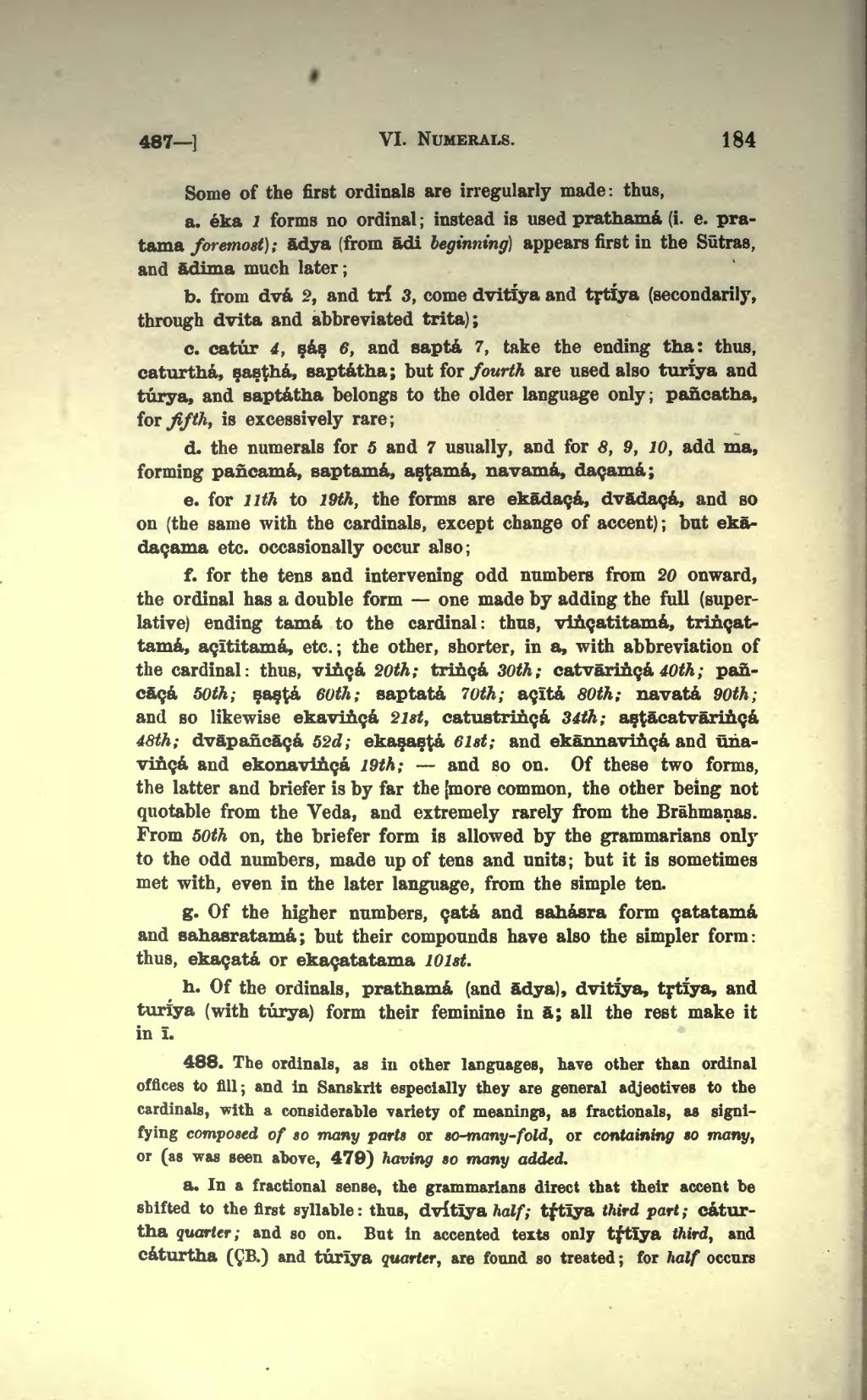Some of the first ordinals are irregularly made: thus,
a. éka 1 forms no ordinal; instead is used prathamá (i. e. pratama foremost); ādya (from ādi beginning) appears first in the Sūtras, and ādima much later;
b. from dvá 2, and trí 3, come dvitī́ya and tṛtī́ya (secondarily, through dvita and abbreviated trita);
c. catúr 4, ṣáṣ 6, and saptá 7, take the ending tha: thus, caturthá, ṣaṣṭhá, saptátha; but for fourth are used also turī́ya and túrya, and saptátha belongs to the older language only; pañcatha, for fifth, is excessively rare;
d. the numerals for 5 and 7 usually, and for 8, 9, 10, add ma, forming pañcamá, saptamá, aṣṭamá, navamá, daçamá;
e. for 11th to 19th, the forms are ekādaçá, dvādaçá, and so on (the same with the cardinals, except change of accent); but ekādaçama etc. occasionally occur also;
f. for the tens and intervening odd numbers from 20 onward, the ordinal has a double form — one made by adding the full (superlative) ending tamá to the cardinal: thus, viṅçatitamá, triṅçattamá, açītitamá, etc.; the other, shorter, in a, with abbreviation of the cardinal: thus, viṅçá 20th; triṅçá 30th; catvāriṅçá 40th; pañcāçá 50th; ṣaṣṭá 60th; saptatá 70th; açītá 80th; navatá 90th; and so likewise ekaviṅçá 21st, catustriṅçá 34th; aṣṭācatvāriṅçá 48th; dvāpañcāçá 52d; ekaṣaṣṭá 61st; and ekānnaviṅçá and ūnaviṅçá and ekonaviṅçá 19th; — and so on. Of these two forms, the latter and briefer is by far the more common, the other being not quotable from the Veda, and extremely rarely from the Brāhmaṇas. From 50th on, the briefer form is allowed by the grammarians only to the odd numbers, made up of tens and units; but it is sometimes met with, even in the later language, from the simple ten.
g. Of the higher numbers, çatá and sahásra form çatatamá and sahasratamá; but their compounds have also the simpler form: thus, ekaçatá or ekaçatatama 101st.
h. Of the ordinals, prathamá (and ādya), dvitī́ya, tṛtī́ya, and turī́ya (with túrya) form their feminine in ā; all the rest make it in ī.
488. The ordinals, as in other languages, have other than ordinal offices to fill; and in Sanskrit especially they are general adjectives to the cardinals, with a considerable variety of meanings, as fractionals, as signifying composed of so many parts or so-many-fold, or containing so many, or (as was seen above, 479) having so many added.
a. In a fractional sense, the grammarians direct that their accent be shifted to the first syllable: thus, dvítīya half; tṛ́tīya third part; cáturtha quarter; and so on. But in accented texts only tṛ́tīya third, and cáturtha (ÇB.) and túrīya quarter, are found so treated; for half occurs
